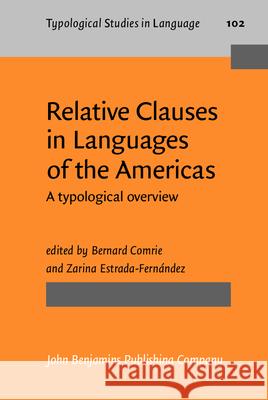Relative Clauses in Languages of The Americas: A Typological Overview » książka
Relative Clauses in Languages of The Americas: A Typological Overview
ISBN-13: 9789027206831 / Angielski
Patterns of relative clause formation tend to vary according to the typological properties of a language. Highly polysynthetic languages tend to have fully nominalized relative clauses and no relative pronouns, while other typologically diverse languages tend to have relative clauses which are similar to main or independent clauses. Languages of the Americas, with their rich genetic diversity, have all been under the influence of European languages, whether Spanish, English or Portuguese, a situation that may be expected to have influenced their grammatical patterns. The present volume focuses on two tasks: The first deals with the discussion of functional principles related to relative clause formation: diachrony and paths of grammaticalization, simplicity vs. complexity, and formalization of rules to capture semantic-syntactic correlations. The second provides a typological overview of relative clauses in nine different languages going from north to south in the Americas.











